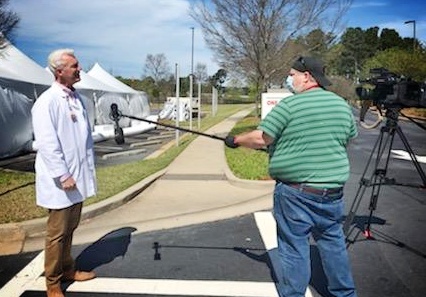Midwest J Schools don’t see Trump bump
Journalism schools in the Midwest are not necessarily seeing the same bump in enrollment from President Trump’s war on the media as their counterparts closer to the nation’s capital.
The Washington Post reported in September that Trump appeared to be “giving a jolt to journalism schools that in recent years struggled to cope with industry contractions.” The Post highlighted the University of Maryland’s Philip Merrill College of Journalism, where the number of freshmen enrolling in journalism increased 50 percent compared with the previous year.
But the story from Trump Country, like much of the news in the middle part of the country, is not the screaming headline it often is on the coasts. The economic forces that pushed college enrollment down for the sixth year in a row in 2018 are still causing declines at traditional journalism schools in the Midwest. At a few schools where journalism enrollment is up, administrators aren’t automatically crediting Trump.
GJR contacted eight schools in the Midwest with undergraduate journalism programs to understand if what was happening at the University of Maryland was part of a national trend. Three were private schools: Northwestern University, Notre Dame University and DePaul University. Five were public schools: University of Illinois at Urbana-Champaign, Southern Illinois University Carbondale, University of Kansas, University of Missouri and Eastern Kentucky University.

Acacia Hernandez, 19, a journalism student at the University of Illinois, where enrollment is down, said journalism can still be a hard choice for students. “People just want to go into something more secure,” she said. “I think journalism is a career that only people who feel strongly about it should go into. People who enroll in journalism should have a strong reason on why they want to do it.”
University of Illinois Urbana-Champaign was one of her top choices because she liked how the school offered a “small program within a big school.”
The undergraduate enrollment at UIUC’s journalism program in the College of Media fell from 2013 to 2018. It had been increasing in previous years with the highest number of enrolled students at 369 for fall 2009, according to UIUC’s Division of Management Information student enrollment report. The journalism program was under the College of Communications until 2008 when the College of Media was created.
Hernandez said Trump’s election did not impact her decision to enter the field of journalism. “I had already decided on journalism before he came into office,” she said.
Journalism enrollment is also down at SIUC, Mizzou and Eastern Kentucky.
At SIUC, where GJR is based, there was a single first year journalism student enrolled this fall. Journalism enrollment had a slight rebound in 2014 with 213 students, according to the school. But it has been falling ever since. In 2017, the school had 109 undergraduate students enrolled.
“I don’t think undergrad enrollment is impacted by President Trump’s remarks over the press,” said Kavita Karan, a former interim director and professor at the School of Journalism at SIUC. “Journalism as a profession is an interest, a passion that will always stand the test of time. Life cannot go on without the media today, and there will always be a demand for journalists.”
She called the decline in journalism enrollment at SIUC a “temporary phase” and attributed it to budgetary constraints and challenges with enrollment more generally at the institution.
Undergraduate journalism enrollment at the University of Missouri has been falling since 2015, the year the school had 1,861 journalism students at its peak, according to the school’s enrollment report. Journalism consistently has been one of the top degrees at Mizzou, ranking No. 5 out of the top 15 most popular undergraduate degree programs at MU, according to the enrollment reports for fall 2013 to fall 2017. Its undergraduate and graduate journalism programs are considered among the best in the country.
Liz McCune, associate director of the MU News Bureau, said Mizzou has “not seen a spike in enrollment because of current political events.”
“University of Missouri as a whole has faced unique enrollment challenges over the past several years, which makes it unlikely that what’s happening at the Missouri School of Journalism is predictive of what’s happening across the country,” she said.
She said journalism students do seem more engaged now than in past years. “I think our students who are starting out in journalism are passionate about being able to tell important stories about what is happening in our country right now.”
Across the Mississippi River, enrollment has remained steady at The University of Kansas William Allen White School of Journalism and Mass Communications, with more than 800 students studying journalism each year for the past five years.
Scott Reinardy, undergraduate associate dean and Malcolm Applegate professor in News Management and Editing, said preliminary numbers for 2018 that show the school on track with the last two or three years. “Our enrollment has been steady over that time,” he said. “We continue to diligently recruit top students and top students continue to enroll in our school, and we’ve seen very consistent numbers over the last few years. Particularly with in state and out of state students equally divided, and those who are interested in different fields of journalism and media.”
Reinardy said there has been an increase in undergraduate applications from 238 in 2016 to 345 in 2018.
He said the political climate does not appear to be a factor. “It hasn’t seemed to affect our enrollment, or we certainly don’t ask students is there a particular reason or political reason why you come to journalism school,” he said.
At Eastern Kentucky University, where enrollment in the College of Letters, Arts, and Social Sciences has been falling since 2013, Jennifer Kaylyn Perkins, 20, is studying journalism and history. She chose her career path before Trump was elected, she said.
“Trump has sparked debate among youth, but so have many other individuals and groups,” she said. “As a generation, we have been empowered by our advisers and leaders to advocate for those who are being treated unjustly. Journalism as a field has changed dramatically in recent years. This field now encompasses both print and digital outlets. The expansion of the career into new territories is attractive to those individuals who wish to express themselves on a large scale.”
Journalism enrollment is up at some private schools, although administrators aren’t sure exactly why.
Northwestern University’s Medill School of Journalism, Media and Integrated Marketing Communications declined to release enrollment data. But The Daily Northwestern student newspaper reported in March that there was a 24 percent enrollment increase from last year. Charles F. Whitaker, interim dean and professor at Medill, told The Washington Post that the increase was a “momentary blip.”
GJR asked Whitaker in an interview what he meant by this. “This information that suggests that our enrollment is up,” he said. “That is generally correct, but we don’t know at the moment what to attribute that to. We’ve been actually going out and talking about journalism. Talking to journalism students about the importance to journalism, and I think that message is resonating. Now it could be that the message is resonating because of the way the President speaks about the press…Our students are feeling very much excited about being in journalism at this time.”
But he cautioned against drawing big conclusions from one year of data. “Everything I say would be totally anecdotal, not empirical or inclusive,” he said.
Enrollment is also up for journalism minors at Notre Dame University, which does not have an undergraduate major but offers a minor through the Gallivan Journalism Program in Journalism, Ethics and Democracy, JED.
Richard Jones, program director of Notre Dame’s JED for two years and a former New York Times journalist, said enrollment is up from fall 2013 to fall 2018 with a 125 percent increase in JED minors. Each year, enrollment in an introductory journalism course also has increased.
“It has been encouraging to see the amount of interest in journalism,” Jones said.
He said students have cited “recent political developments” as an impetus to get the journalism minor.
“The election of 2016, no matter which side of the political spectrum you’re on, was certainly a pivotal moment in our nation’s history,” he said. “One of those before and after moments. I think that students of all political backgrounds really saw something in that moment that made them want to contribute as journalists or study journalism.”
Several of Notre Dame’s students have indicated that they are not sure if they want to pursue a career in journalism, he added. “But they are curious about how the process of producing and distributing news works.”
Jones said it’s too soon to tell whether any enrollment increases in journalism programs will continue. “I think it certainly is an opportunity for us as educators to engage in students in some new and important way,” Jones said. “I think one of the takeaways for us all is that journalism is alive and well.”
It has not translated into an increase in enrollment at all private schools, however. Columbia College Chicago has seen a dip in its journalism enrolment in the past several years, although the number of students studying social media and photojournalism is up.
For Whitaker, the Trump Era remains an important time, for educators, for journalism and for journalists. “It is important for our media to be watchdogs of public officials. To tell important stories of underrepresented communities,” he said. Whitaker said journalism is “stressed” not only by attacks from politicians, but also by a general distrust in media and by a business model that is broken at the moment. “There are a lot of stresses on journalism that threaten the institution, but I have every confidence that journalism will survive this period,” he said. “And that we will better served and the public will be better served as the result of it.”
Journalism enrollment at DePaul University is also up. The number of freshman applications to the journalism program increased 17 percent. In fall 2014, there were 347 applications and this fall 2018 it went up to 406. The number of freshman enrollments who have declared a journalism major increased 33 percent, 57 this fall compared to 43 in fall 2014 said Carol Hughes, executive director of News and Integrated Content of DePaul University’s Office of Public Relations and Communications.
Meanwhile, Hernandez hopes to work for a production news network once she graduates from the University of Illinois.
Trump’s verbal attacks on journalists affect people’s viewpoints on journalism and on news itself. That is why “so many people in society think journalism is dying,” she said, when just the opposite is happening. “It is just evolving and changing,” she said. “I think that is what is bringing those numbers down, people believing those lies.”


